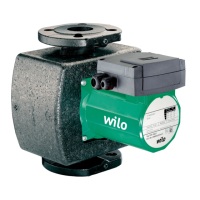English
42 WILO SE 05/2011
7.2.1 Collective fault signal (SSM)
DANGER! Danger of death!
Improper electrical connections pose a risk of fatal injury due to electric
shock.
If the mains leads and SSM lead are brought together in a 5-core cable, the
SSM-lead must not be monitored using a protective low voltage.
For pumps with terminal boxes of types 5 and 7 (Fig. 4) a collective fault signal
“SSM” for connection to the building automation system is available as a poten-
tial-free NC relay (max. contact loading 250 VAC/1A). The contacts open if the
integral motor protection trips to disconnect the motor. After a manual reset
(Fig. 4, item 4) at the pump, the contacts close again and the fault signal is
acknowledged.
If the collective fault signal “SSM” is connected to an external Wilo switch/con-
trol unit using the “WSK” (terminal 15, 10) facility, any fault that occurs should
first be acknowledged at the pump and then at the switch/control unit.
7.2.2 Motor protection
CAUTION! Risk of damage!
If the winding protection contact (WSK) of the pump is not connected to
a motor protection system, the motor can be damaged due to thermal
overload!
Pump with terminal
box type
Tripping SSM Fault acknowl-
edgement
TOP-S
TOP-SD
TOP-Z
TOP-RL
TOP-I
1~230 V
1
(P
1
max 265 W)
Internal switching off
of motor voltage
-
Automatically, after
the motor has cooled
down
2
(P
1
max 265 W)
Internal switching off
of motor voltage
-
Automatically, after
the motor has cooled
down
3
(320 W P
1
max
400 W)
WSK and external trip-
ping unit (SK602/
SK622 or other switch/
control unit)
-
Manually at the trip-
ping unit, after the
motor has cooled
down
4
(320 W P
1
max
400 W)
WSK and external trip-
ping unit (SK602/
SK622 or other switch/
control unit)
-
Manually at the trip-
ping unit, after the
motor has cooled
down
5
(650 W P
1
max
960 W)
All-pole switching off
by the integral tripping
electronics
Tripping the SSM is
performed in parallel
with switching off of
the integral tripping
electronics
Manually at the
pump, after the
motor has cooled
down

